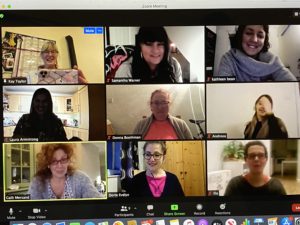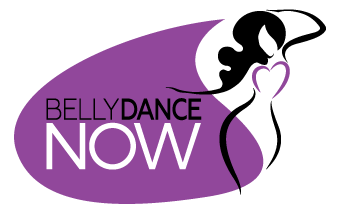Posted on 21/07/2021 by Kay Taylor
5 tips for teaching effectively via Zoom
By international dancer, performer and movement expert Dorte Evelyn, founder of the Ishtar Dance  Academy.
Academy.
For more than 3 years leading up to the Corona pandemic, I was teaching online using Zoom as well as other online platforms, so I guess I was prepared for the lockdown and everything that followed. But I still decided to make some changes to ensure my online classes were taught in an effective and professional way.
We now also teach this as part of our Bellydance Safely course which has an entire module dedicated to Zoom; how to use, how to troubleshoot, and not least how to use it in a way that still allows you as a teacher to check your students progress, and your students to enjoy and learn from the session too.
Why is this needed?
Teaching online requires different skills, and classes and workshops often need to be structured differently too. Many will have encountered and probably also [by now] resolved the sound issues that occur when you try to talk over the music. But there can still be problems with lag and not being in time with the music.
Why may you want to know all this as the world returns to ‘normal’? Because we have all moved on, and online classes are here to stay. They give students as well as teachers, the opportunity to teach beyond their locality. The convenience of not having to leave your house is – believe it or not – still a big selling point for some, and it gives the flexibility to be working and delivering classes even when you’re on the road. I will for example be teaching workshops from abroad this year via zoom and should I have to self-isolate or strand somewhere, then I will still be able to run these.
So what are the key basics to remember when using zoom…
1 Get your connection right
You can’t help students who may live in an area where there isn’t broadband, but you can ensure that you have the best possible connection your end to enable the best possible user experience.
Wi-fi can vary, so where possible I always recommend investing in an Ethernet cable [£5-£20] that you can plug into your computer for the most stable connection possible. If this isn’t possible, then make sure you are as close to your wi-fi as possible and that no one else if using is for high-intensity stuff such as gaming or streaming when you need it.
As with all electrical devices restarting your wi-fi hub is good practice too, which can help overcome a sluggish connection.
 2 Help your students get set up
2 Help your students get set up
Even after several years of zoom meetings you would think that the entire world has become zoom super users, but that is not necessarily the case. So make sure you help your students get the set up right at their end too.
You can either pull a guide together for them ahead of your session, or you can spend 10-15 minutes going through how it works with them before your class starts.
Here it is user end tips that matter; how to switch the views, what to do if the connection goes, what to do if there is a lag and image and sound get out of sync etc.
Do also spend a few minutes get your students set up in their dance space to ensure it’s safe, well-lit, that you can see them clearly etc.
3 Get the sound right
Make sure to do a sound test before your class, so your students can feedback and you can all proceed with confidence.
Whether you have a mixer set up, or are relying on the suppression of background noise on zoom – it’s always worth muting your participants and then do some counting over the music to see if everyone can hear you ok and that that there are no timing or other issues with the sound.
There are hundreds of YouTube tutorials on how to get the set up right, so you can find all this for free online. We also spend quite a bit of time on how to set this up and test it during our Safety Course, as it’s through the practical application of this that you learn and gain the confidence needed to assist your students too.
4 Get your set up right
This includes everything from background, lighting, and even to what you wear! A distracting background can make it really difficult to see and follow moves, and distracting shadows don’t help either. Again, there are plenty of free YouTube tutorials to get you started or to improve your existing setup.
Make sure to have portable lights at hand, especially if you teach during different times of the day. And keep your clothing bright or colorful so moves show more easily to your students.
Make sure you test your set up if possible before the class starts either by doing a recording or simply by asking the first student that enters your virtual classroom.

Zoom Safety course with Dorte & Galit
5 Adapting your teaching skills for online
So everything is set and you’re ready to start teaching – but have you structured your lesson to work for the online medium? Online teaching requires different skills than normal face-to-face teaching but everyone can learn it.
Communication is key, as is showing moves and combinations from different angles, because learning in 2-D is a lot harder than if you’re in the room.
Encourage your students to ask questions, and make sure that you take the time to monitor their progress and to feedback. If their setup isn’t great, then this may be tricky, which is why it’s important to take the time to get point 2 right.
Mirroring moves is obviously an essential skill for Zoom as well as the dance studio, but you also need to be mindful of how you structure your class, as people’s attention span often is lower when learning online. Keeping combinations simpler or building them up in a more structured way will help your students learn and not least enjoy the class more.
And finally, don’t forget to ask for feedback from your students too. Teaching via a screen can sometimes become/feel one-sided, so use the time on either side of your lesson to engage with your students and find out what worked and what needs improving.
We never finish learning, and this is very much the ethos of JWAAD too, and why I enjoy delivering courses such as the Bellydance Safely course – also online. To go direct to book your place on our next course starting on 13/14th November click here.
To find out more about Dorte visit the Ishtar Dance website: www.ishtardance.com
